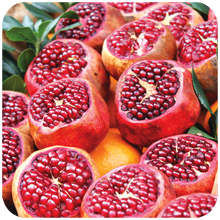
Punica granatum is a fruit shrub. It has dimensions of 3-8 meters depending upon the variations. Leaves are deciduous, lanceolate shape, 3-8 cm long, shiny. In autumn season, leavs turns in a beautiful golden color. Pomegranate blooms in May-August, with single or double flowers of different colors: red-orange, red-orange with white seam, white, salmon or yellow. The corolla is bell-shaped, consists of 5-7 petals. Pomegranate produces fruits in age from 3-4 years up to 20 years. Fruits (pomegranate) are edible, globular in shape with a diameter of approx. 10 cm, reddish in color. Inside, the fruit has a pink pulp and numerous seeds separated by membranes.
Chemical composition-
Organic acids: citric, malic, tartaric, fumaric, succinic, ascorbic acids.
Cyclytol carboxylic / hydroxybenzoic acid, quinic acid, gallic acid, ellagic acid.
Hydroxycinnamic acids: caffeic acid, chlorogenic acid, p-coumaric acid.
Flavan 3-ols / Flavonoids and their glycosides: catechin, epicatechin, epigallocatechin-3-gallate, quercetine, rutine.
Anthocyanins: cyanidin-3-O-glucoside, cyanidin 3,5-di-O-glucoside, delphinidin-3-O-glucoside, delphinidin 3,5-di-O-glucoside, Pelargonidin-3-O-glucoside, Pelargonidin -3,5-di-O-glucoside.
Amino acids: proline, valine, methionine, aspartic acid and glutamic acid.
Indoleamine: tryptamine, serotonine, melatonine
Tocopherols- α – tocopherol.
Elagitannins: Punicaline, Punicalagine, Corylagine, Casuarinin, Galagildilactone.
Properties – Cardiac tonic, astringent, anthelmintic, amoebicide, antimalarial, antimicrobial, antioxidant, cytotoxic, hypoglycemic, anemic, energizing.
Recommendations – Anemia, diarrhea, dysentery, trichomonasis, hemorrhoids, intestinal parasites, asthenia, chronic fatigue, fever, fungal infections.
This plant is incorporated in natural remedy GLOBY FORTE.




